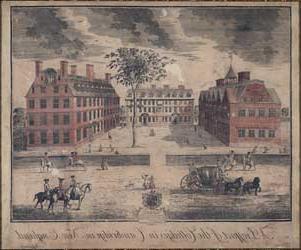收藏在线
A Prospect of the Colledges in Cambridge in New England
-
Choose an alternate description of this item written for these projects:
- 见证美国的过去
- MHS收集历史
- MHS 225周年纪念
William Burgis's view of Harvard College in 1726 was the first engraving to focus on an American college. Of the three buildings portrayed in the engraving, only one, 马萨诸塞州霍尔, survives today.
一个偶然的发现
A Prospect of the Colledges in Cambridge in New England has shaped the modern mental 图像 of higher education in colonial America, yet the 马萨诸塞州历史学会's copy, 唯一现存的, 是偶然发现的. In 1795, the Society received an uncolored 1743 version of the engraving (请参阅在线演示),它被安装在一块木板上. 到1880年,木板开始变形. In order to protect the engraving against damage, a member of the Society removed it and underneath discovered the handsome, 用手工上色, and previously unknown first state of the 图像, painted by William Burgis in the mid 1720s and then engraved, 可能在英国, 约翰·哈里斯. An advertisement for the engraving--now known familiarly as the Burgis View--in the Boston News Letter of 26 July 1726 dates the work.
美国殖民地的高等教育
In 1726, American higher education had a ninety-year history, but over that period the colonists had organized only three colleges. Following the founding of Harvard College in 1636, fifty-seven years passed before the establishment of the College of William and Mary in Williamsburg, 维吉尼亚州, in 1693. The only other American college in 1726 was Yale College, founded in 1701 and located in several different Connecticut towns before settling in New Haven by 1718.
Although artists had previously included both Harvard and William and Mary within larger scenes, the Burgis View was the first work to focus on an American college. The institution the artist depicted was the American colonies' largest, 最富有的, and most prominent institution of higher education. In 1726, Harvard had a faculty of six as well as a librarian and a steward (or business manager) to teach and mind a student body of approximately 150. 学校的三栋建筑之一, 哈佛堂(左), 建于1674年至1678年, 是机构的核心吗. In addition to dormitory chambers for two junior faculty members (called tutors) and thirty-nine students, 哈佛大楼是图书馆的所在地, 厨房, 还有大厅, 用于用餐和教堂服务. In 1764, 大楼被夷为平地的时候, 哲学室也在里面, where the professor of mathematics and natural philosophy offered basic instruction in the sciences. 斯托顿学院(中), 建于1698年的宿舍, had rooms for at least one member of the faculty and about thirty students. 马萨诸塞州霍尔, 也是宿舍, was only six years old in 1726; it accommodated two tutors and about sixty students. Undergraduates for whom the college lacked space found places in town with college-approved Cambridge families. Of the buildings Burgis painted, only 马萨诸塞州霍尔 is still standing.
William Burgis's view of Harvard College quickly came to epitomize higher education in the American colonies. Reproduced frequently in photographs and engravings, it has also appeared on a wide variety of ephemeral items ranging from matchbook covers to coffee mugs to towels. 如果你看到这个视图的再现, check the credit line: although the MHS owns the only surviving copy of this engraving, publishers have sometimes requested (and received) permision from such repositories as Harvard's Houghton Library and the Library of Congress to use the 图像.
og体育平台艺术家
William Burgis, probably English-born, first came to public attention in New York, where his A South Prospect of the Flourishing City of New York in the Province of New York in America, was published as an engraving in four sections between 1719 and 1721. By 1722, he was in Boston, publishing a panoramic engraving entitled A South East View of the Great Town of Boston in New England in America in 1725. 在每一个项目中, Burgis played an entrepreneurial role: he painted his subject, 找到了一个雕刻师, then promoted and sold the resulting prints. At a time when American artists concentrated on portraits to the near exclusion of other subjects, Burgis was remarkable for his attention to landscapes. Thirteen of his works survive, the earliest from 1719, the last from about 1731.
后面的视图
Harvard as William Burgis depicted it remained largely unchanged until 1744, 当它增加了第四栋建筑, 霍尔顿教堂. By 1767, when Paul Revere engraved the college the school had added another dormitory-Hollis (1763, second from left)-and a new Harvard Hall (center, 1766) as a replacement for the building lost in 1764. (Please see the online presentation of a 1916 re-engraving of the Revere view). 里维尔的景色很现代, although the figures and coach give it an unmistakably eighteenth-century flavor. 与布尔吉斯的观点相反, which includes only one structure still standing, of the five in the Revere engraving only Stoughton College (second from right) no longer exists.
进一步阅读建议:
彩旗,班布里奇. 《哈佛:建筑史. 剑桥,麻.:哈佛大学出版社,1985.
理查德·B·霍尔曼. 《威廉·伯吉斯》,中 出版物 of the Colonial Society of Massachusetts 46 (1973): 57-81.
莫里森,塞缪尔艾略特. 哈佛三个世纪,1636-1936. 剑桥,麻.:哈佛大学出版社,1936.
我是汉密尔顿·沃恩. Views of Harvard: A Pictorial Record to 1860. 剑桥,麻.:哈佛大学出版社,1949.
赖特,康拉德·埃迪克. Revolutionary Generation: Harvard Men and the Consequences of Independence. 阿默斯特,质量.: University of Massachusetts Press, 2005.

